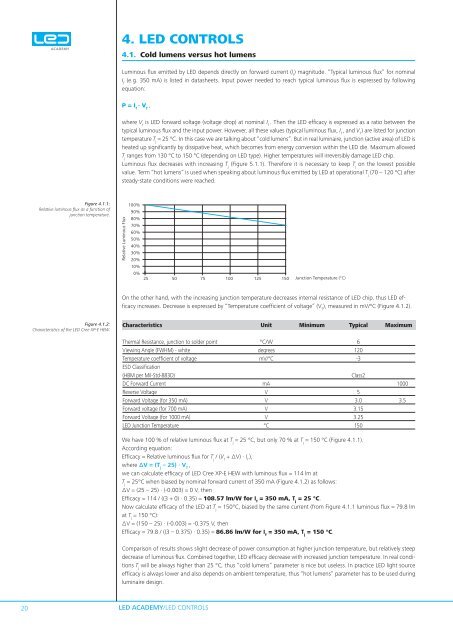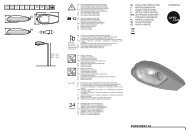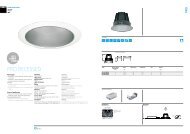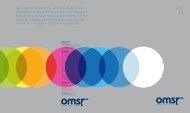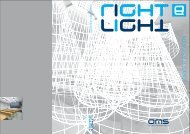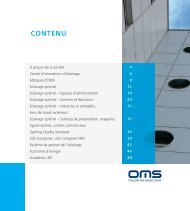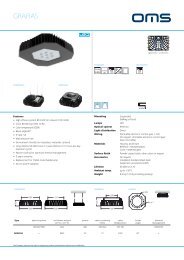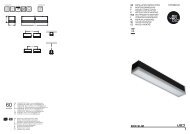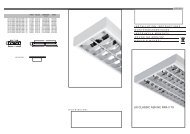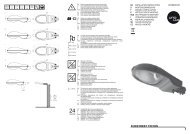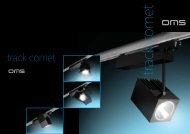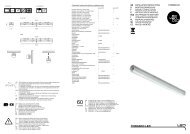Create successful ePaper yourself
Turn your PDF publications into a flip-book with our unique Google optimized e-Paper software.
4. <strong>LED</strong> CONTROLS4.1. Cold lumens versus hot lumensLuminous flux emitted <strong>by</strong> <strong>LED</strong> depends directly on forward current (I f) magnitude. “Typical luminous flux” for nominalI f(e.g. 350 mA) is listed in datasheets. Input power needed to reach typical luminous flux is expressed <strong>by</strong> followingequation:P = I f · V f,where V fis <strong>LED</strong> forward voltage (voltage drop) at nominal I f. Then the <strong>LED</strong> efficacy is expressed as a ratio between thetypical luminous flux and the input power. However, all these values (typical luminous flux, I f, and V f) are listed for junctiontemperature T j= 25 °C. In this case we are talking about “cold lumens”. But in real luminaire, junction (active area) of <strong>LED</strong> isheated up significantly <strong>by</strong> dissipative heat, which becomes from energy conversion within the <strong>LED</strong> die. Maximum allowedT jranges from 130 °C to 150 °C (depending on <strong>LED</strong> type). Higher temperatures will irreversibly damage <strong>LED</strong> chip.Luminous flux decreases with increasing T j(Figure 5.1.1). Therefore it is necessary to keep T jon the lowest possiblevalue. Term “hot lumens” is used when speaking about luminous flux emitted <strong>by</strong> <strong>LED</strong> at operational T j(70 – 120 °C) aftersteady-state conditions were reached.Figure 4.1.1:Relative luminous flux as a function ofjunction temperature.Relative Luminous Flux100%90%80%70%60%50%40%30%20%10%0%25 5075 100 125150Junction Temperature (°C)On the other hand, with the increasing junction temperature decreases internal resistance of <strong>LED</strong> chip, thus <strong>LED</strong> efficacyincreases. Decrease is expressed <strong>by</strong> “Temperature coefficient of voltage” (V T), measured in mV/°C (Figure 4.1.2).Figure 4.1.2:Characteristics of the <strong>LED</strong> Cree XP-E HEW.Characteristics Unit Minimum Typical MaximumThermal Resistance, junction to solder point °C/W 6Viewing Angle (FWHM) - white degrees 120Temperature coefficient of voltage mV/°C -3ESD Classification(HBM per Mil-Std-883D)Class2DC Forward Current mA 1000Reverse Voltage V 5Forward Voltage (for 350 mA) V 3.0 3.5Forward voltage (for 700 mA) V 3.15Forward Voltage (for 1000 mA) V 3.25<strong>LED</strong> Junction Temperature °C 150We have 100 % of relative luminous flux at T j= 25 °C, but only 70 % at T j= 150 °C (Figure 4.1.1).According equation:Efficacy = Relative luminous flux for T j/ (V f+ ΔV) · I f),where ΔV = (T j– 25) · V T,we can calculate efficacy of <strong>LED</strong> Cree XP-E HEW with luminous flux = 114 lm atT j= 25°C when biased <strong>by</strong> nominal forward current of 350 mA (Figure 4.1.2) as follows:ΔV = (25 – 25) · (-0.003) = 0 V, thenEfficacy = 114 / ((3 + 0) · 0.35) = 108.57 lm/W for I f= 350 mA, T j= 25 °C.Now calculate efficacy of the <strong>LED</strong> at T j= 150°C, biased <strong>by</strong> the same current (from Figure 4.1.1 luminous flux = 79.8 lmat T j= 150 °C):ΔV = (150 – 25) · (-0.003) = -0.375 V, thenEfficacy = 79.8 / ((3 – 0.375) · 0.35) = 86.86 lm/W for I f= 350 mA, T j= 150 °C.Comparison of results shows slight decrease of power consumption at higher junction temperature, but relatively steepdecrease of luminous flux. Combined together, <strong>LED</strong> efficacy decrease with increased junction temperature. In real conditionsT jwill be always higher than 25 °C, thus “cold lumens” parameter is nice but useless. In practice <strong>LED</strong> light sourceefficacy is always lower and also depends on ambient temperature, thus “hot lumens” parameter has to be used duringluminaire design.20 <strong>LED</strong> <strong>ACADEMY</strong>/<strong>LED</strong> CONTROLS


